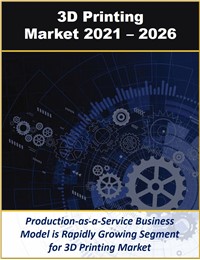This report provides multi-dimensional analysis of the 3D Printing market including hardware manufacturers, service providers, application providers, software providers, raw material providers, and communities. The report also assesses the market impact of intellectual property, different technologies and strategies, raw material supplies, and other key factors across industry verticals globally and regionally including forecasts for 2021 to 2026.
This report also evaluates companies involved in the 3D printing solutions value chain. For example, HP’s MJF technology is a powder-based 3D printing technology that does not rely upon lasers. MFJ uses fine-grained materials, allowing for layers as thin as 80 microns. Thin printed layers have higher density and lower porosity, leading to smooth surfaces right out of the printer. Applications of MFJ 3D printing include prototypes for form, fit and function testing.
Select Report Findings:
- Production-as-a-Service business model is fast-growing solution area
- Design and engineering for 3D printing will expand beyond traditional 2D CAD technologies
- Growth of new materials is spawning a 3D printing market for previously unaddressed products
- Desktop 3D printer usage will be the foundation for an emerging prosumer SMB and SOHO marketplace
- Substantial 3D printing market growth anticipated outside traditional manufacturing such as the medical device market
- While North America, Asia Pac, and Europe are largest 3D printing markets, MEA region is fastest-growing globally
Key verticals that Mind Commerce sees for the 3D printing market include:
- Aeronautics/Space
- Architecture/Construction
- Chemical
- Drones/Robotics
- Education
- Energy
- Food
- Healthcare
- Maritime Industry
- Mechanics
- Retail Electronics
Robotic automation is advancing 3D printing applications beyond conventional manufacturing to encompass delivery of products and assets where and when they are needed. For example, specialized robotics are enabling innovative structure construction such as buildings, bridges, and other physical infrastructure. An example of one company that is leveraging the combination of robotics and 3D printing is Aectual.
The company’s 3D printing system incorporates a robotic arm with six degrees of directional freedom and the ability to move freely between these axes. With a range of 360 degrees, Aectual can print across an area of 500 sq. ft, allowing for the creation of large-scale objects and massive single prints. The company claims that their design to delivery process reduces the cost of custom-made architectural projects by up to 50%. Aectual produces prefabricated decorative pieces as well as specialized customer designs at a higher cost.
In the healthcare arena, 3D printed prosthetics is facilitating significantly faster design and delivery for amputee solutions as well as prototyping and try-before-you-buy for patients. 3D custom implants provide efficient and substantially more expeditious delivery of bone replacement material for cancer patients. In fact, Mind Commerce sees 3D printing in the healthcare market rapidly moving to mainstream adoption and usage by 2024 within certain niche medical care supply vendor markets.
In the enterprise and industrial arena, the fabrication, integration, and control of virtually any product is increasingly becoming digitized. This trend is accelerating as evidenced by recent surveys indicating that 3D Printing and other forms of additive manufacturing will have a positive impact, increase creativity and dramatically improve time to market, especially for certain goods and services.
3D printing communities of interest (such as those entities that use 3D printers and related tools including the use of more plugins or online apps) will move beyond mere integrated 3D printing networks to become a larger scale ecosystem. This is anticipated to be a fully integrated 3D ecosystem including 3D design, modelling and simulations, prototyping, and fabrication. This is driven in part by lower-cost communications infrastructure and services as well as availability and adoption of tools to support 3D including immersive tech and IoT solutions.
We see an emerging producer-consumers (e.g. “prosumer”) marketplace emerging for 3D printing in which everyday consumers engage in at least one part of the evolving connected manufacturing industry. Some trivial examples exist today such as Hero Forge, a company that provides tools for consumers to construct their own uniquely customizable fantasy roleplaying figures.
We anticipate that the ability for self-help design and manufacturing with this prosumer model will become commonplace for many durable goods, causing disintermediation throughout supply chains, most notably with traditional manufacturers and retail outlets.
Report Benefits:
- 3D Printing Forecasts for 2021 to 2026
- Analysis of leading 3D printing companies
- Identify challenges and opportunities for 3D Printing
- Identify investment trends and leading market players
- Identify trends in raw materials for flexible manufacturing
- Recognize the market direction and future of the 3D Printing
- Understand the 3D Printing Ecosystem including roles of players
- Understand the relationship of 3D printing relative to AI and IIoT



